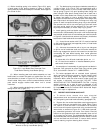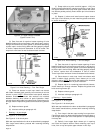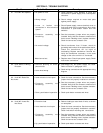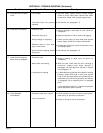
Page 18
(1) Using a known load, equal to the hoist rated load,
energize hoist to lift the load. Raise this load just high enough
to be certain hoist is lifting the entire load. Clutch should not
slip with the rated load. Lower load to rest position. If clutch
slips with rated load, adjustment is required. (See paragraph
7-5. — “OVERLOAD CLUTCH ADJUSTMENT”.) If hoist will lift
rated load, proceed to step (2).
(2) Increase load in steps from rated load, TO A MAXIMUM
OF 200% of the rated load, attempting to lift load with each
increase in weight. Hoist Overload Clutch should slip and refuse
to lift load before 200% of the rated load is reached. Should
hoist lift 200% of the rated load — STOP TEST — A CLUTCH
ADJUSTMENT IS REQUIRED. (See paragraph 7-5 —
“OVERLOAD CLUTCH ADJUSTMENT”.)
(3) Run hoist with load causing clutch to slip (hoist refusing
load) five cycles of approximately 1 second each.
(4) Remove weights added in step (2) and return to hoist rated
load. Lift rated load one final time. Clutch should not slip.
To prevent overheating, release the hoist control button at
once when the hoist refuses to lift the load.
CAUTION
Do not lift more than rated load except for test
purposes.
WARNING
NOTICE
ALWAYS KNOW LOAD TO BE LIFTED, LIFT-TECH
DOES NOT RECOMMEND LIFTING LOADS GREATER
THAN THE RATED LOAD OF YOUR HOIST.
BEFORE ATTEMPTING TO TEST THE OVERLOAD
CLUTCH, MAKE CERTAIN THE FOLLOWING
PREREQUISITES ARE STRICTLY OBSERVED:
a. An appointed person must determine, before
starting, that all structures supporting the hoist are
adequately strong to withstand the test load of 200%
of the rated load, plus the weight of the hoist, whether
hoist is tested in installed position or moved to a
designated test facility.
b. Loads used for testing must be accurately known.
c. Test must be made ONLY by a qualified operator,
thoroughly familiar with the hoist and the purpose of
the test.
d. Adequate and proper rigging must be provided to
ensure that test loads are securely attached, properly
balanced, and lifted level. Failure to provide adequate
support could cause injury to personnel and/or damage
to equipment.
WARNING


















